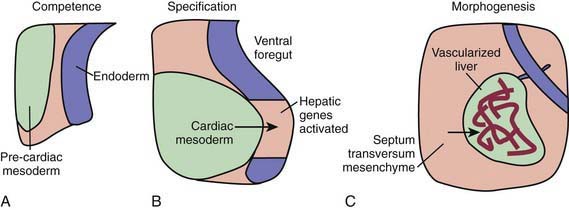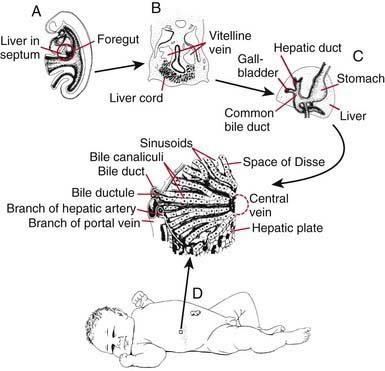Chapter 346 Morphogenesis of the Liver and Biliary System
Morphogenesis of the liver and biliary system is a complex process. It follows that altered development has significant consequences, including cholestatic disorders such as Alagille syndrome and biliary atresia.
During the early embryonic process of gastrulation, the 3 embryonic germ layers (endoderm, mesoderm, ectoderm) are formed. The liver and biliary system arise from cells of the ventral foregut endoderm; their development can be divided into 3 distinct processes (Fig. 346-1). First, through unknown mechanisms, the ventral foregut endoderm acquires competence to receive signals arising from the cardiac mesoderm. These mesodermal signals, in the form of various fibroblast growth factors (FGFs) and bone morphogenetic proteins (BMPs), lead to specification of cells that will form the liver and activation of liver-specific genes. During this period of hepatic fate decision, “pioneer” transcription factors, including Foxa and Gata4, bind to specific binding sites in compacted chromatin, open the local chromatin structure, and mark genes as competent. But these will only be expressed if they are correctly induced by additional transcription factors. Newly specified cells then migrate in a cranial ventral direction into the septum transversum in the 4th wk of human gestation to initiate liver morphogenesis.

Figure 346-1 Processes involved in early liver development. A, The ventral foregut endoderm acquires competence to receive signals arising from the cardiac mesoderm. B, Specific cells of the ventral foregut endoderm undergo specification and activation of liver-specific genes under the influence of mesodermal signals. C, Liver morphogenesis is initiated as the newly specified cells migrate into the septum transversum under the influence of signaling molecules and extracellular matrix released by septum transversum mesenchymal cells and of primitive endothelial cells.
(Reprinted from Zaret KS: Liver specification and early morphogenesis, Mech Dev 92:83–88, 2000;
The growth and development of the newly budded liver require interactions with endothelial cells. Certain proteins are important for liver development in animal models (Table 346-1). In addition to these proteins, microRNA, which consists of small noncoding, single-stranded RNA, have a functional role in the regulation of gene expression and hepatobiliary development in a zebrafish model.
Table 346-1 SELECTED GROWTH FACTORS, RECEPTORS, PROTEIN KINASES AND TRANSCRIPTION FACTORS REQUIRED FOR NORMAL LIVER DEVELOPMENT IN ANIMAL MODELS
INDUCTION OF HEPATOCYTE FATE THROUGH CARDIAC MESODERM
INDUCTION OF HEPATOCYTE FATE THROUGH SEPTUM TRANSVERSUM
Bone morphogenetic proteins 2, 4, 7
STIMULATION OF HEPATOBLAST GROWTH AND PROLIFERATION
SPECIFICATION OF HEPATOCYTE LINEAGE
SPECIFICATION OF CHOLANGIOCYTE LINEAGE
Within the ventral mesentery, proliferation of migrating cells forms anastomosing hepatic cords, with the network of primitive liver cells, sinusoids, and septal mesenchyme establishing the basic architectural pattern of liver lobule (Fig. 346-2). The solid cranial portion of the hepatic diverticulum (pars hepatis) eventually forms the hepatic parenchyma and the intrahepatic bile ducts. The hepatic lobules are identifiable in the 6th week of human gestation. The bile canalicular structures, including microvilli and junctional complexes, are specialized loci of the liver cell membrane; these appear very early in gestation, and large canaliculi bounded by several hepatocytes are seen by 6-7 wk.

Figure 346-2 Hepatic morphogenesis. A, Ventral outgrowth of hepatic diverticulum from foregut endoderm in the 3.5 wk embryo. B, Between the two vitelline veins, the enlarging hepatic diverticulum buds off epithelial (liver) cords that become the liver parenchyma, around which the endothelium of capillaries (sinusoids) align (4 wk embryo). C, Hemisection of embryo at 7.5 wk. D, Three-dimensional representation of the hepatic lobule as present in the newborn.
(Reprinted from Andres JM, Mathis RK, Walker WA: Liver disease in infants. Part I: developmental hepatology and mechanisms of liver dysfunction, J Pediatr 90:686–697, 1977.)
Hepatocytes and bile duct cells (cholangiocytes) originate both from hepatoblasts as common precursors. Notch signaling, which is impaired in Alagille syndrome, promotes hepatoblast differentiation into biliary epithelium, whereas hepatocyte growth factor (HGF) antagonizes differentiation. The development of the intrahepatic bile ducts is determined by the development and branching pattern of the portal vein. Around the 8th week of gestation, starting at the hilum of the liver, primitive hepatoblasts adjacent to the mesenchyme around the portal vein branches form a cylindrical sleeve, termed the ductal plate. From 12 weeks of gestation onward, a “remodeling” of the ductal plate occurs, with some segments of the ductal plate undergoing tubular dilatation and excess epithelial tissue gradually disappearing. The ramification of the biliary tree continues throughout fetal life and at the time of birth the most peripheral branches of the portal veins are still surrounded by ductal plates; these require 4 more weeks to develop into definitive portal ducts. Lack of remodeling of the ductal plate results in persistence of primitive ductal plate configurations, an abnormality called ductal plate malformation. This histopathologic lesion has been observed in liver biopsies of a variety of liver conditions, including congenital hepatic fibrosis, Caroli disease, and biliary atresia.
The caudal part (pars cystica) of the hepatic diverticulum becomes the gallbladder, cystic duct, and common bile duct. The distal portions of the right and left hepatic ducts develop from the extrahepatic ducts, whereas the proximal portions develop from the first intrahepatic ductal plates. The extrahepatic bile ducts and the developing intrahepatic biliary tree maintain luminal continuity and patency from the beginning of organogenesis (see Fig. 346-2C).
The transport and metabolic activities of the liver are facilitated by the structural arrangement of liver cell cords, which are formed by rows of hepatocytes, separated by sinusoids that converge toward the tributaries of the hepatic vein (the central vein) located in the center of the lobule (see Fig. 346-2D
Stay updated, free articles. Join our Telegram channel

Full access? Get Clinical Tree


